Dear Reader, in this age of AI created content, please support with your goodwill someone who works harder to provide the human-made. Sign up at the top of the lefthand column or bottom of this page. You will receive my hand illustrated monthly newsletter RESTORE NATURE and access to the biodiversity garden design course as I write...and nothing else, I respect your time. I am also removing the advertizing as best I can as its become intrusive inappropriate and pays me nothing.
Why
perennials are the silver bullet for soil health
Permaculture and regenerative soil
management practices to increase soil fertility and plant health.
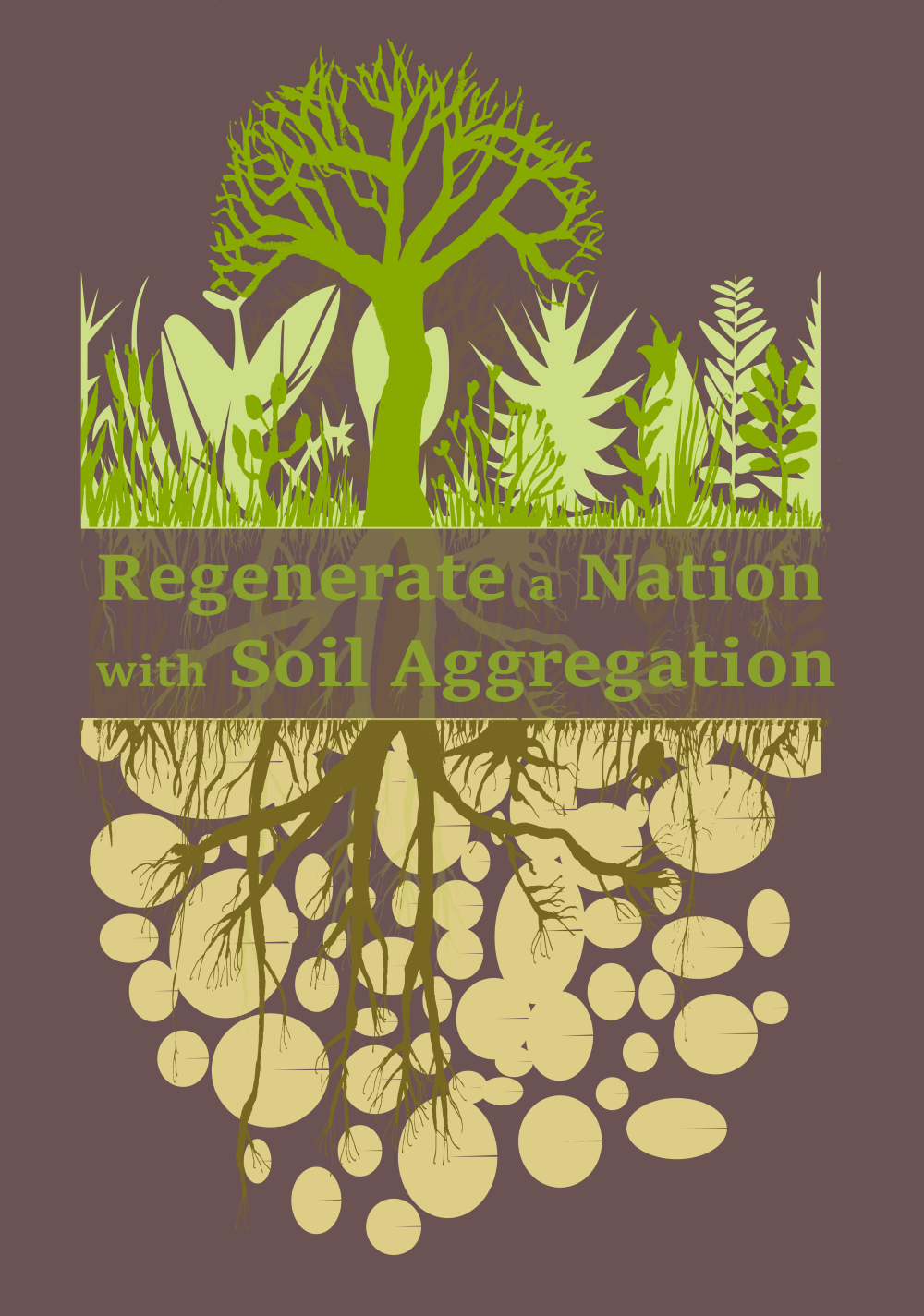 My soil health design printed on clothing, decor items and accessories. See link to the shop below.
My soil health design printed on clothing, decor items and accessories. See link to the shop below.The basis of fertility is soil health. This depends on a living soil, with a resilient and diverse microbiome. Plants are the biggest 'weapon' or 'tool' in creating this life in the soil. They are more important than all the carefully made composts and other concoctions used by a committed and enthusiastic gardener.
If you would like to support my writing so that I can keep on delivering information on restorative gardening to you, please buy the book advertized in the right hand column, or a t-shirt with my design at this link. The right t-shirt is brilliant for starting conversations on soil health.
Soil health, permaculture and perennials
Permaculture is based on the idea of permanent culture, or how to grow food gardens in a way that is lasting and permanent rather than degenerative, like most of agriculture today. One could also say based on the food forest idea, that it is about how to plant so that food provision is permanent and the plantings are permanent, requiring minimal intervention. This idea also fits in beautifully with regenerative soil management practices.
 A classic perennial vegetable, asparagus. Taro and Malabar spinach in the background.
A classic perennial vegetable, asparagus. Taro and Malabar spinach in the background.Soil health is a side effect of perennial planting
Creating healthy soil is so easy, it can be incorporated into gardening at no cost, and into farming with clever planning of resource management, or some initial capital outlay for converting from non sustainable agricultural systems to regenerative farming practice. Regenerative farming builds top soil, whose depth increases year by year under regenerative soil management. Farming subsidies all around the world need to be changed to support regenerative farmers, or the transition process to regenerative farming, instead of supporting those caught in the downward spiraling vicious cycle of high input costs caused by excessive chemical use and consequent soil loss.
But how do we create living soil ? For many years I thought the addition of organic material in the form of compost and mulch was the answer. I brewed teas and made indigenous microorganism concoctions. None of this returned the garden to its golden years when it was green and healthy all year round with no watering and very little maintenance. In those years it was planted up with perennial native plants I had carefully selected for their adaptation to sandy seaside soils. The conversion to a food producing garden with many annual food plants was the start of my trouble with fertility and disease in the garden.
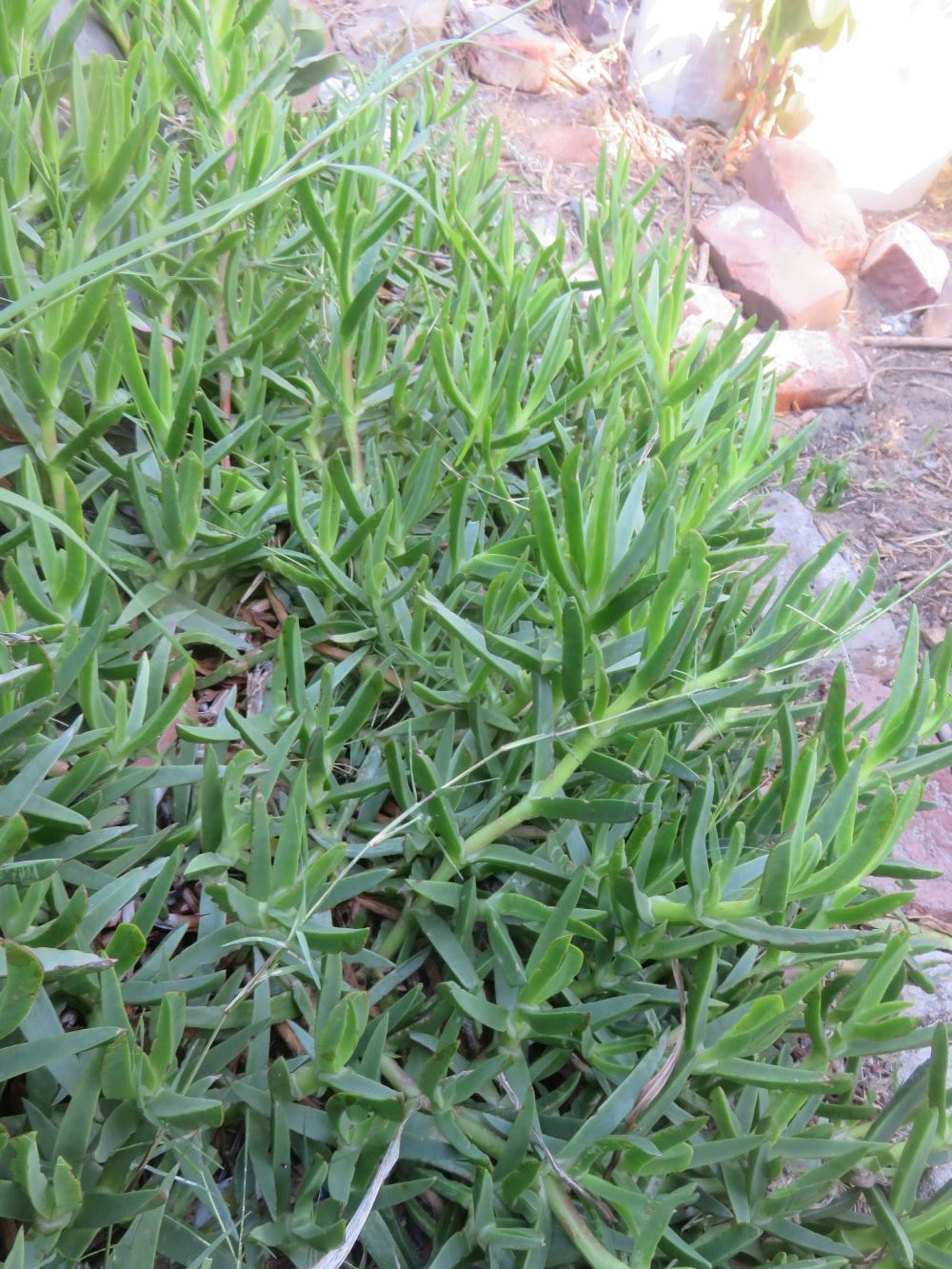 A native perennial food plant and ground cover, Carpobrotus edulis
A native perennial food plant and ground cover, Carpobrotus edulisThe big AHA on soil health
Recently I was granted a 'bursary' to study soil advocacy at Kiss the Ground, an NPO highly active internationally in the advocacy for a global transition to regenerative farming. Thank you Kiss the Ground. The mulled bark scales fell from my eyes.
Organic soil additives are good, vermicompost and composted manures are very good, but they are not enough if this is all you are doing. They are also not practical on a large farm-scale because of the cost. However they are highly suited to small scale soil management, the kind found in a small suburban garden. In the urban household, the outputs from the house to the compost heap are large in comparison to the surface area of land, and are almost by products of 'living', and can be produced at no extra cost
The thing I discovered was beautiful, simple and already known. However, the scientific insight from new research references by Kiss the Ground, cast things in a new light that utterly changed my perspectives on soil care. This completely changed the way I garden. I recommend that anyone interested in permaculture, restoration or environment do this course. If you already know a lot, they will at the very least make you a more empowered and effective environmental activist. They supply you with multiple reference points to call on when you are talking to people, and help you develop your powers of persuasion, which is a major focus of the course.
The biggest thing for me on the learning journey was the importance of plants in soil regeneration. In retrospect I can't understand how I missed it all along, but then I didn't have enough information to understand that point, before I did the course, despite having completed a PDC and written about and researched on permaculture for three years. It is amazing how you can miss the jist of things.
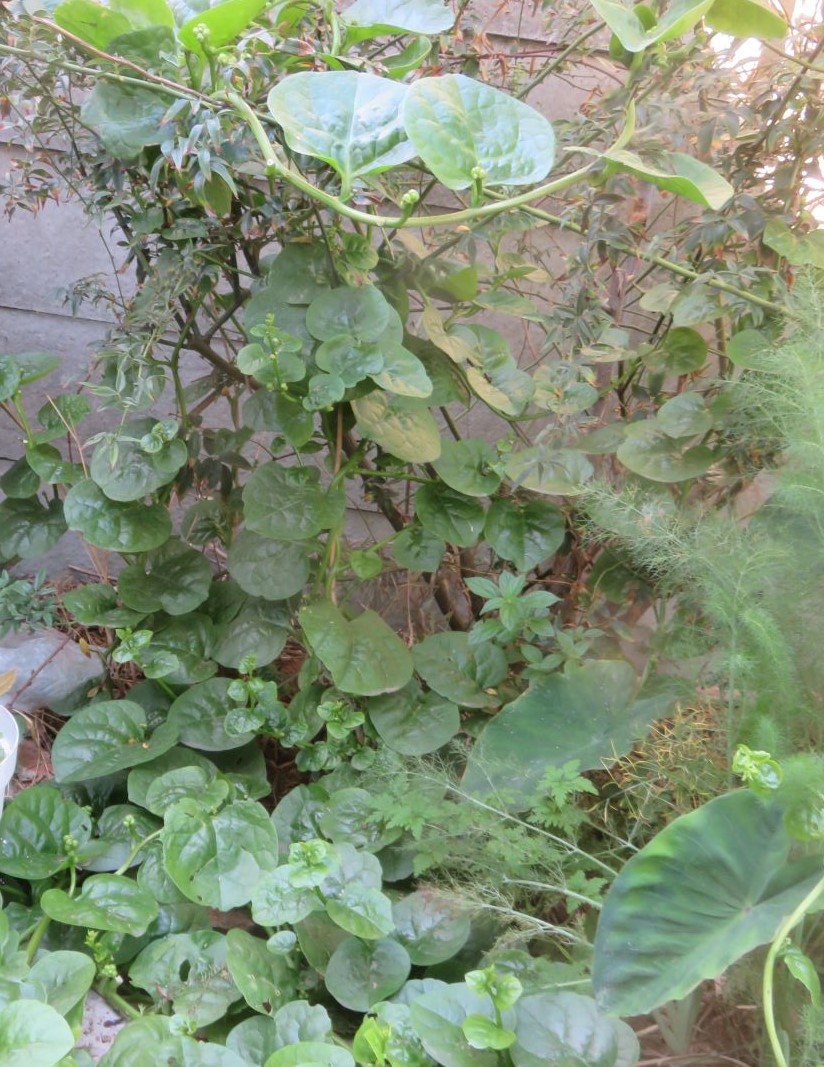 An exotic perennial climbing leaf vegetable, Basella alba
An exotic perennial climbing leaf vegetable, Basella albaWhy plants are the silver bullet for soil health
Well, plants basically support in numerous ways, the diversity of life forms in the soil that make it function at its peak. Any single benefit of plants is difficult to separate from the others as there are so many positive feedback loops or virtuous cycles. So what are these ways that plants nurture soil life ?
Plants can cover the earth, they shade and protect it from the harsh, sterilizing rays of the sun, so that plants or shaded soil can be from 10 to 60 degrees cooler than naked soil or paved surfaces. Just providing shade helps with the survival of a greater diversity of soil organisms.
Plants can penetrate the earth. The deep penetration of roots provide easier deep penetration of rain and oxygen. Plant roots also pull up minerals from the subsoil, or degraded rock. Plant roots hold soil with their numerous tiny roots and prevent it from washing away. Soil that is held in place by roots lives and deepens, whereas soil that is compacted and degraded, or soil that is washed away is completely disorganized and unable to hold anything.
But most importantly
for soil health....
Plants photosynthesize. We have long
known that plants absorb carbon dioxide and release oxygen during
photosynthesis, the process of turning light energy into storable
energy in sugars. We have thus known for a long time that
photosynthesis changed the earth's atmosphere from one dominated by
carbon dioxide to one prepared for oxygen breathing organisms like
ourselves. We also have known that these sugars are the basis for
life, harnessing energy for the plant internal processes which build
more molecules like complex carbohydrates, proteins, and other
phytochemicals which are the building blocks of life. The majority of
living organisms either photosynthesise, or eat organisms which
photosynthesize, or eat those organisms, dividing life forms by what
they do for energy into autotrophs like plants, or heterotrophs like
herbivores, parasites and carnivores. Life is an energy absorbing
process, and the whole web of life is made
possible by passing on to other life forms the energy that plants
harness from the sun. But this was known. There is much much more to photosynthesis and its knock on effects.
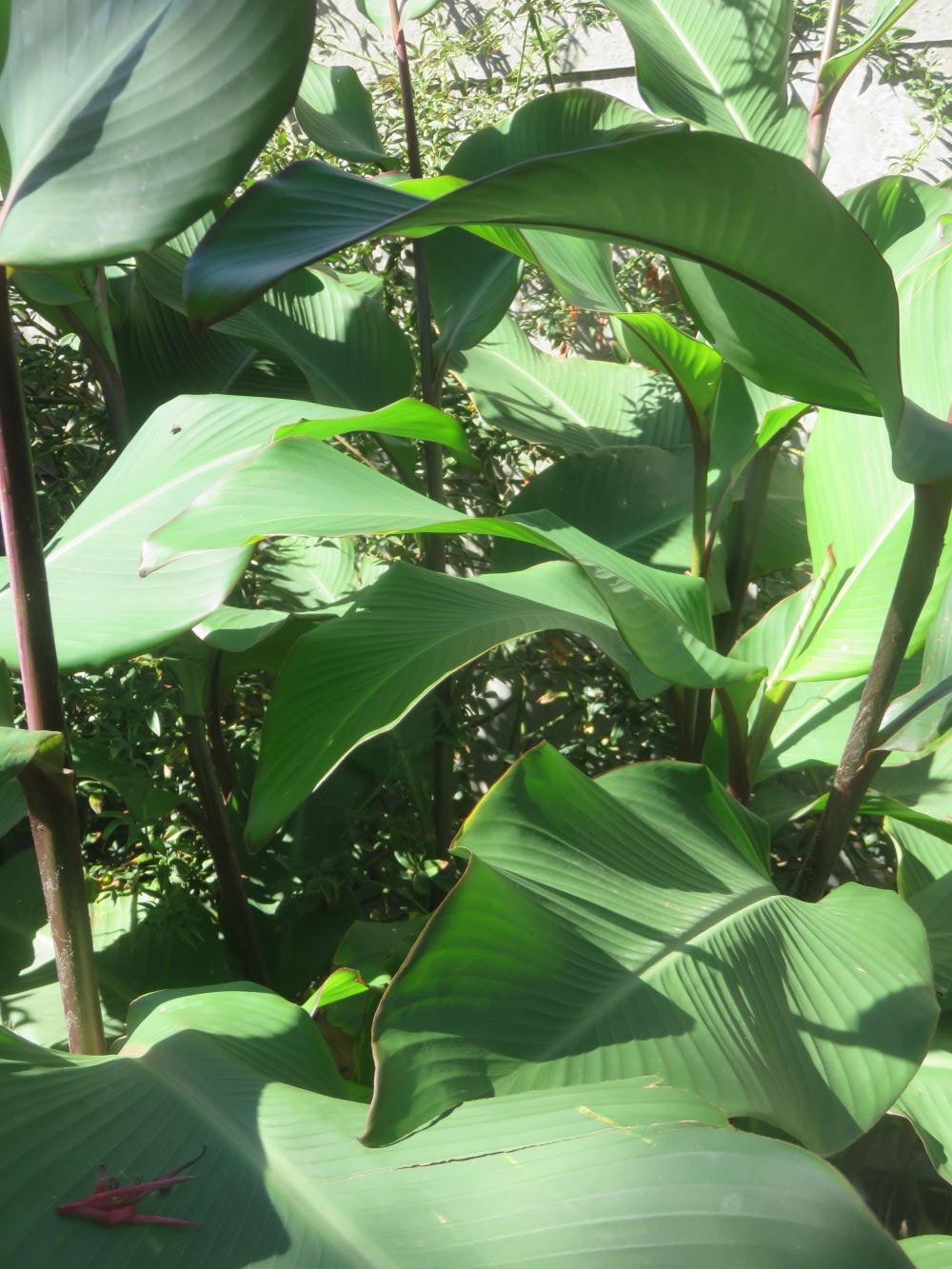 These massive self replicating perfectly designed solar panels pump energy into the life in the ground whenever the sun shines
These massive self replicating perfectly designed solar panels pump energy into the life in the ground whenever the sun shinesHidden life and liquid carbon
I had read Peter Wohlleben and The Hidden Life of Trees. It was marvelous the way he described how trees in a forest cared for each other, nurturing saplings and seemingly dead stumps, feeding them with sugars via the mycelial web.
What was new to me was the extent of this sugar, or liquid carbon reaching the soil. A huge portion, up to forty percent of the sugar plants produce, finds its way into the soil around the roots, and forest trees in Germany are by no means just an interesting exception. It is the plants that do not shed sugar which are the anomalies.
Not only to most plants shed sugars, they tailor the type of sugar mixes to support specific organisms like bacteria which will supply them with quite specific nutrients. The sugars also feed fungal hyphae which transport nutrients to them from distances out of the range of their root hairs, extending the range of absorption of the roots enormously. The plants thus create their own nutritient supply through an exchange where the currency is sugar, or in a more egalitarian anti capitalist metahpor, in a barter of sugars for minerals.
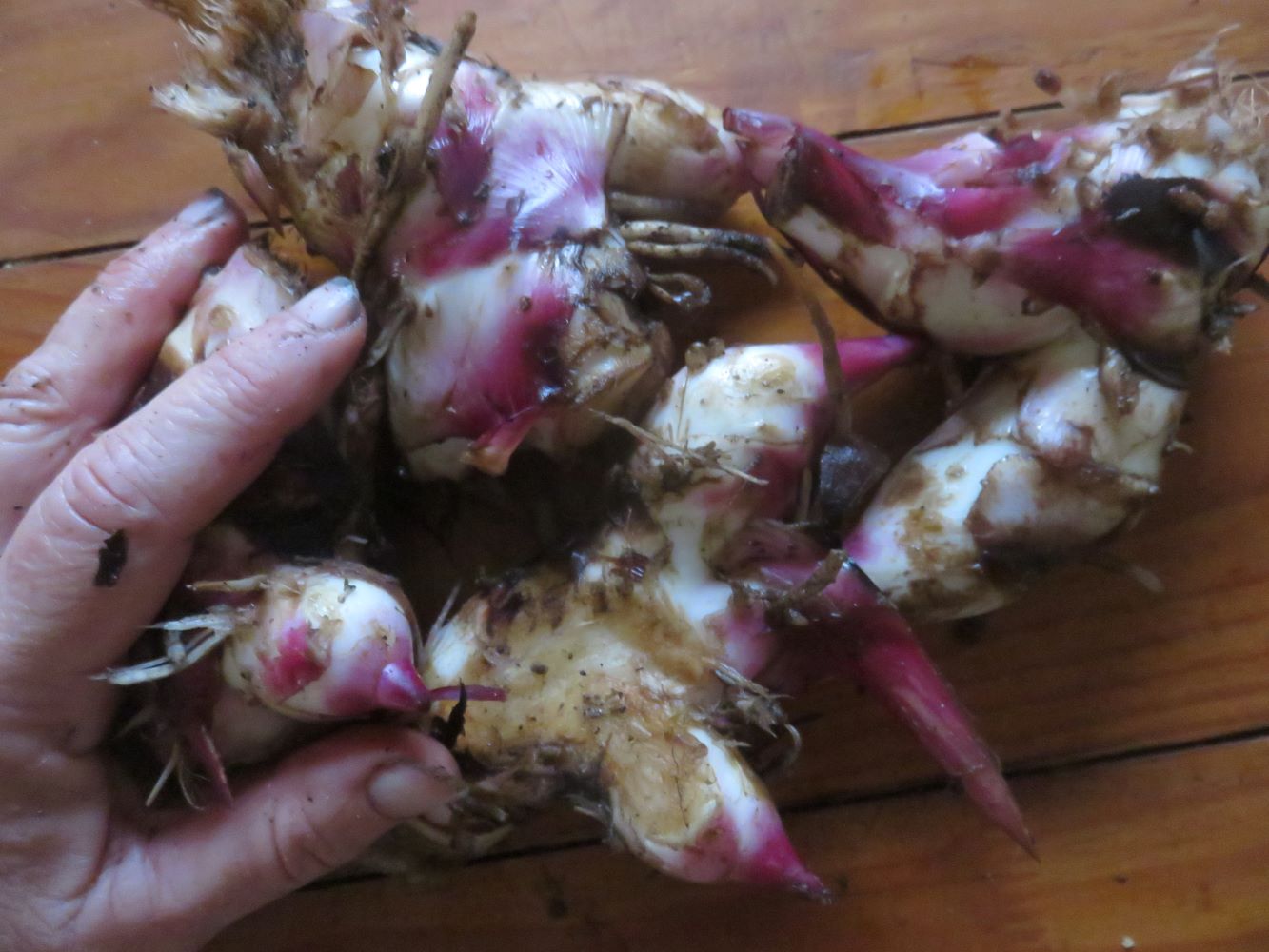 Food for the microbes and food for we. The amazing perennial arrowroot.
Food for the microbes and food for we. The amazing perennial arrowroot.Most of the minerals are made plant available by bacteria in the root's immediate vicinity or rhizosphere, once it has depleted, the root must move on, and the hyphae help very much with nutrient supply, and even the transport of bacteria, like commuters on the underground, because the bacteria are miniscule in comparison to the hyphal tubes.
These bacteria need a protected environment, as they are preyed on by other organisms, and the hyphae and bacteria together create 'fortresses' for the bacteria by clumping soil particles together to create protected space in the interstices between the soil particles. These clumps are called aggregates. They are held together by the fungal threads and by glues like glomalin that some bacteria produce. The aggregates form in the immediate vicinity of the roots, and can be seen clinging to the fine root hairs in a plant that is pulled up from good soil.
Aggregation is everything in
soil health
So the sugars from the plant are major drivers in the creation of soil aggregates via their support of the aggregate building life forms like hyphae and bacteria. The sugars are transported along hyphae and used by organisms in the aggregates to produce stable humic complexes which one author likens to chemical springs between the soil particles that significantly increase pore space.
The formation of aggregates is everything. It creates clumps in the soil, with tiny micropores inside the clumps, and gaps between the clumps, or macropores, and this is known as soil structure.
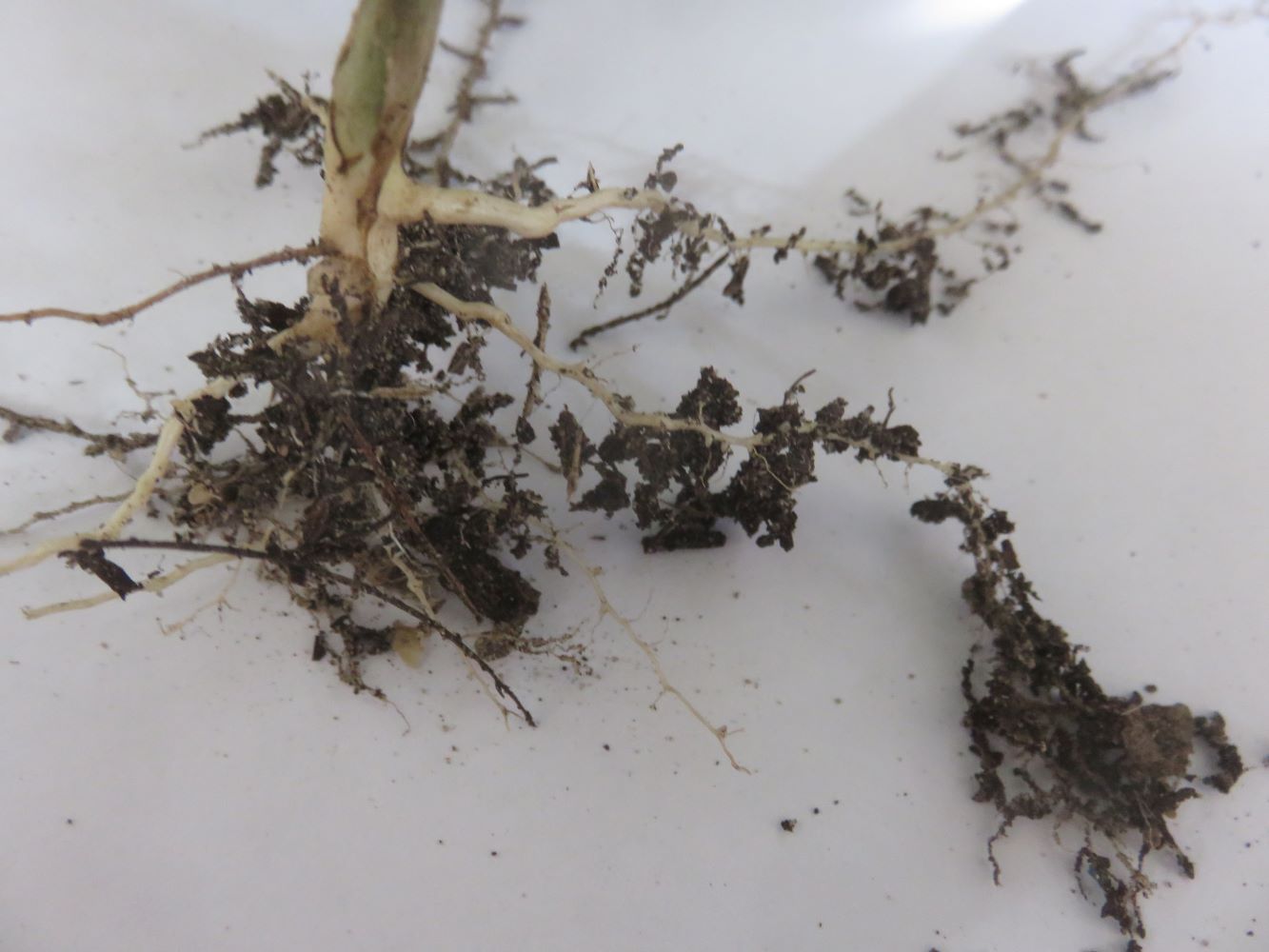 The beginnings of aggregate formation on the roots of one of my cover crop seedlings. Sorry plant, sorry microbes, needed you for the photograph. Will try and put you back.
The beginnings of aggregate formation on the roots of one of my cover crop seedlings. Sorry plant, sorry microbes, needed you for the photograph. Will try and put you back.The soil sponge is a benefit of soil health
A well structured soil is like a sponge. Beyond sheltering beneficial bacteria and other organisms in micropores, the aggregation and the macropores lead to a raft of benefits such as increased oxygen and root penetration, water penetration and water holding capacity, nutrient retention, and resistance to erosion.
These direct benefits, perhaps not intended by the microbes, lead to indirect benefits which are enormous in their scope, improving the whole ecosystem's function. The benefits of soil aggregates will be addressed in a future article I'm writing on soil, so stay with me. That article will outline the richly complex web of positive feedback loops which arise from creating living soil.
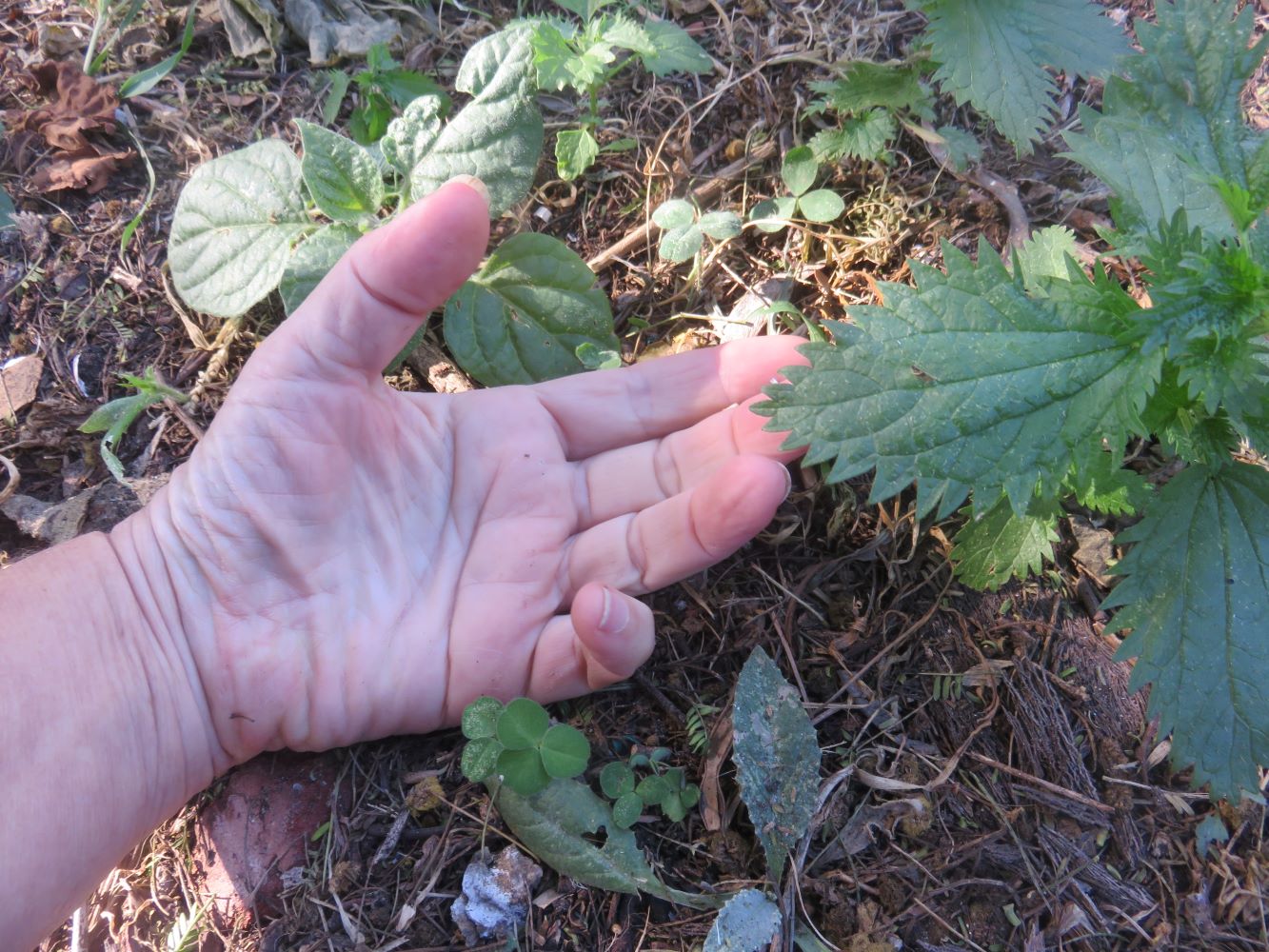 Leave them be and just receive. My new 40 species cover crop mix emerges. See native amaranth, clover, artichokes and nettles.
Leave them be and just receive. My new 40 species cover crop mix emerges. See native amaranth, clover, artichokes and nettles.Plants are your biggest lever in creating soil health
For the time being I will stay with the topic of how to start these virtuous cycles of soil health. The sugars exuded into the earth far exceed in their impact on soil carbon content the addition of dead organic matter to the surface of the soil. They thus do more work adding carbon than mulches and composts.
The mulch serves its function mainly as a protector of the soil, and the compost is not a nutrient provider as much as a fabulous innoculator, for compost has a rich and diverse microbial ecosystem of its own, if it is not too old and burned out. The compost is like the probiotics or actual living cultures consumed for your own gut microbiome. You can add microbial diversity with these, or you can increase diversity by eating the right foods called prebiotics, to feed your microbes. Prebiotics for humans are complex carbohydrates, and I've found out that they are the safer way to nurture your microbiome in the long run. The prebiotics for soil life are also carbohydrates, aka the plant sugars.
Why perennials for soil health ?
In the immediate vicinity of the plant roots is a complex underground ecosystem. In the rhizosphere, in intimate contact with the roots, beneficial microbes form a protecting shield around the root that physically prevents pathogen entry. In the vicinity of the rhizosphere, a high number of aggregates shelter beneficial bacteria which make minerals and other nutrients available in plant friendly form. They only live close to the source of plant sugars from the roots. They constantly produce new aggregates. If you rip up the plant by the roots, you remove their life supply line and the whole tiny ecosystem in the root vicinity crashes.
What to do ?
The 6 points of the 'how to' of soil health in the next article
The next article is about how to create living soil, using plants and other means, to implement regenerative practices in an urban garden.
------
home page for lots of links to permaculture, restorative gardening and off grid living topics
------
saving our soil page with links to soil fertility topics
------
the next article in this series on the 6 ways to restore soil health and create living soil.
Restore Nature Newsletter
I've been writing for four years now and I would love to hear from you
Please let me know if you have any questions, comments or stories to share on gardening, permaculture, regenerative agriculture, food forests, natural gardening, do nothing gardening, observations about pests and diseases, foraging, dealing with and using weeds constructively, composting and going offgrid.
SEARCH
Order the Kindle E-book for the SPECIAL PRICE of only
Prices valid till 30.09.2023
Recent Articles
-
garden for life is a blog about saving the earth one garden at a time
Apr 18, 25 01:18 PM
The garden for life blog has short articles on gardening for biodiversity with native plants and regenerating soil for climate amelioration and nutritious food -
Cape Flats Sand Fynbos, Cape Town's most endangered native vegetation!
Apr 18, 25 10:36 AM
Cape Flats Sand Fynbos, a vegetation type found in the super diverse Cape Fynbos region is threatened by Cape Town's urban development and invasive alien plants -
Geography Research Task
Jan 31, 25 11:37 PM
To whom it may concern My name is Tanyaradzwa Madziwa and I am a matric student at Springfield Convent School. As part of our geography syllabus for this
"How to start a profitable worm business on a shoestring budget
Order a printed copy from "Amazon" at the SPECIAL PRICE of only
or a digital version from the "Kindle" store at the SPECIAL PRICE of only
Prices valid till 30.09.2023







